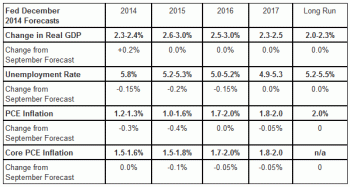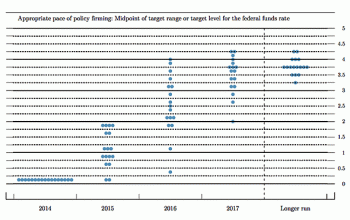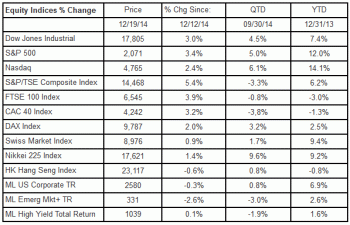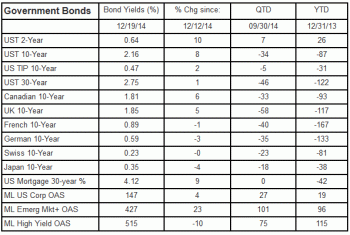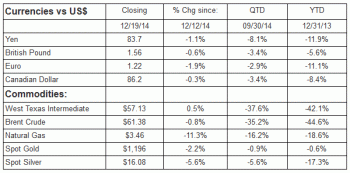John Davidson’s Economic Comments: Week ending Dec. 19
Falling oil prices have dominated the capital markets in recent weeks. This week, a reassuring U.S. Federal Trade Commission took some pressure off the negative sentiment. Economic releases from the U.S. were mostly positive, but the releases from Europe and Asia were mixed. Worries remained over the spillover effects from the oil price declines and the impact of the collapse of the price of Russian assets. Nonetheless, equity markets rallied around the globe. U.S. interest rates rose, but those in Europe and Asia were mixed; high yield credit spreads narrowed, partially recovering the widening that occurred when oil prices first fell; investment grade and emerging market spreads widened on the week. The U.S. dollar gained again this week. Oil prices were split, but natural gas and metals commodity prices were lower on the week.
Perspective:
After this week's recovery, equity investors wonder if the rally will continue into 2015. While technical analysts focus on head and shoulders charts and momentum indicators, fundamental investors, such as this author, look at price-earnings ratios and valuation metrics. The S&P 500 closed at 19.48 times its historic 12 month earnings. Using estimates from Birinyi Associates, the S&P 500 closed at 17.15 times their forward estimate of earnings. The forward P/E ratio indicates that if earnings are reported as estimated and the prices of the S&P 500 companies do not change, the historic P/E ratio at the end of 2015 will be 17.15 times historic earnings. The higher than average P/E ratio indicates that the valuations are on the expensive side. Future stock market rallies will need to come from surprise growth in earnings, not expansion of the P/E ratio.
Author's note: No Comments well be distributed next Friday, but there will be Holiday and Year-End 2014 Comments.
Economic Releases:
The Federal Open Market Committee meeting and its releases appeared to give comfort to the markets. While the Fed kept rates unchanged at 0-25 bp and ended QE, it maintained its policy of reinvesting the principal payments from its MBS portfolio and of reinvesting proceeds from matured Treasuries. In lieu of the statement that rates would be kept low for "considerable time," the Fed changed its focus to being "patient" on the increase in rates. In her press conference, Fed Chair Janet Yellen stated that the change of language did not represent a change in the Fed's intention. The dissenters split on whether the Fed was falling behind the curve by not acting sooner and whether the Fed was acting too soon that might choke off the recovery.
The Fed released its quarterly economic indicators as shown below in the table. As shown in the table below, Real GPD growth is higher and Unemployment and inflationary expectations are lower than previously estimated. There were little changes in long term expectations; most of the changes occurred near term.
The "Dots" chart at right shows each FOMC participant's expectation for the Federal Reserve Funds Rate. In comparison to prior expectations, the increases from the current 0-25 bp range are spread further out to a longer horizon and are more gradual. The chart shows that in 2017 the FOMC participants believe that the rate will approach the "Longer run" expectations; increases in 2015 will be modest; there is a wide dispersion of expectations for 2016, from 0.375% to 4.00%. These expectations helped to offset concern over the removal of the "considerable time" description from the Fed's statement.
Other Economic Releases
The weekly Initial Jobless Claims for the week of Dec. 13 came in at 289,000, near the low end of the range of expectations; the four-week average inched lower to 298,750. Continuing Claims fell 147,000 lower to 2.373 million; the unemployment rate among the insured workers ticked down to 1.8%, its recovery low. The flash Purchasing Managers Index for Manufacturing dropped a point to 53.7 in December; the Services flash PMI report dropped 3 points to 53.6; both remained well inside the expansion zone (above 50). In November, Industrial Production rose 1.3% and Capacity Utilization rose to 80.1%; both numbers were better than the range of expectations. Also in November, U.S. Housing Starts and Permits were 1.028 and 1.035 million respectively; both were below the upwardly revised October numbers.
In the Eurozone, the Composite, Manufacturing, and Services flash PMI's each rose to 51.7, 50.8, and 51.9 respectively. Germany's flash PMI for Manufacturing rose, but the PMI for Services fell; at 51.4, 51.2 and 51.4, all three remained in the expansion zone. France's flash PMI's rose, but at 49.1, 47.9, and 49.8, all remain in the contraction zone. In the UK, November Retail Sales increased 1.6%, better than expected and after an upward revision in the October Sales.
The Bank of Japan met and left interest rates unchanged; the BOJ indicated it would continue buying bonds at an annual rate of 80 trillion Yen. Japan's flash PMI for Manufacturing remained unchanged at 52.1. China's flash PMI for Manufacturing dropped a half point to 49.5 into the contraction zone.
Equities Markets:
This week, the U.S. equity markets experienced the first daily back to back 2+% gains since March of 2009. This week's rally lifted equity markets across the globe; yet, even with this gain the equity markets closed below the levels of just two weeks ago. The energy sector rebounded 9.7% covering some of the losses incurred in prior weeks. When oil prices first tumbled it took a toll on the high yield market; this week the spreads narrowed on high yield debt and gave the Merrill Lynch High Yield Total return a slight positive return in spite of the rising interest rates in the US.
Bond Markets:
Government bond yields were higher in North America, but a bit lower elsewhere. In the credit markets the High Yield spreads experienced a partial recovery from the oil-drop related collapse a couple of weeks ago.
Currencies & Commodities:
The U.S. dollar continued to rally this week against the other four currencies in the table. WTI oil prices increased, but Brent Crude prices declined on the week; yet both closed down more than a third quarter to date and over 40% since the beginning of the year. Metals and natural gas commodity prices also declined on the week.
John W. Davidson, CFA, started writing these Comments more than a decade ago as a personal discipline when he was promoted from portfolio manager to chief investment officer and CEO.

Most recently, he was the president of PartnerRe Asset Management Corporation, responsible for the management of PartnerRe's invested assets, which grew from $4 billion to $12 billion during his tenure. After joining PartnerRe in the fall of 2001, he hired the staff, built the trading floor and created the infrastructure to manage both fixed income and equity assets internally. He retired from PartnerRe at the end of 2008 and moved to Maine, where he focused on board work.
He has more than 35 years of industry experience, including positions with investment management responsibility for separate institutional accounts, mutual funds, trusts and insurance assets. Prior to joining PartnerRe, he served as president and chief executive officer of two other investment management companies. For various companies he has held positions as chief investment officer, chief economist, head of fixed income and portfolio manager. As a portfolio manager, Davidson managed and traded U.S. Government Securities as well as futures and options on fixed income instruments.
His real world experience is backed by a strong academic foundation, which includes earning a Master of Business Administration in finance and a Master of Arts in mathematics from Boston College, as well as a Bachelor of Arts, cum laude, in economics from Amherst College. He holds the professional designation of chartered financial analyst.
His experiences and credentials have brought him to the public as a television commentator and conference speaker. In addition to his frequent past appearances on CNBC, CNNfn, Bloomberg TV and Yahoo FinanceVision, he appeared as a special guest on Wall $treet Week with Louis Rukeyser. Reuters, Bloomberg and other business press services have quoted his views on the market. He has taught CFA preparation programs, as well as other courses offered by the Stamford and Boston CFA Societies, and the National Graduate Trust Officers' School.
Davidson is a natural leader in both his professional and personal life, having developed those skills early in his career as a naval officer. He spent three years on active duty, which included a year on the rivers of Vietnam, and 24 years in the Naval Reserve, from which he retired as a captain in 1994.
Davidson is treasurer and board member of the Camden Conference. He is also on the investment committee of the Pen Bay Health Foundation. He serves as an independent trustee for mutual funds.
In his leisure time, he is an active sailor, tennis player and skier. With his wife, Barbara, he renovated a 100+-year-old home in Camden, where they enjoy spending time with their two golden retrievers and having visits from their five children. He can be reached at jwdbond@me.com.


